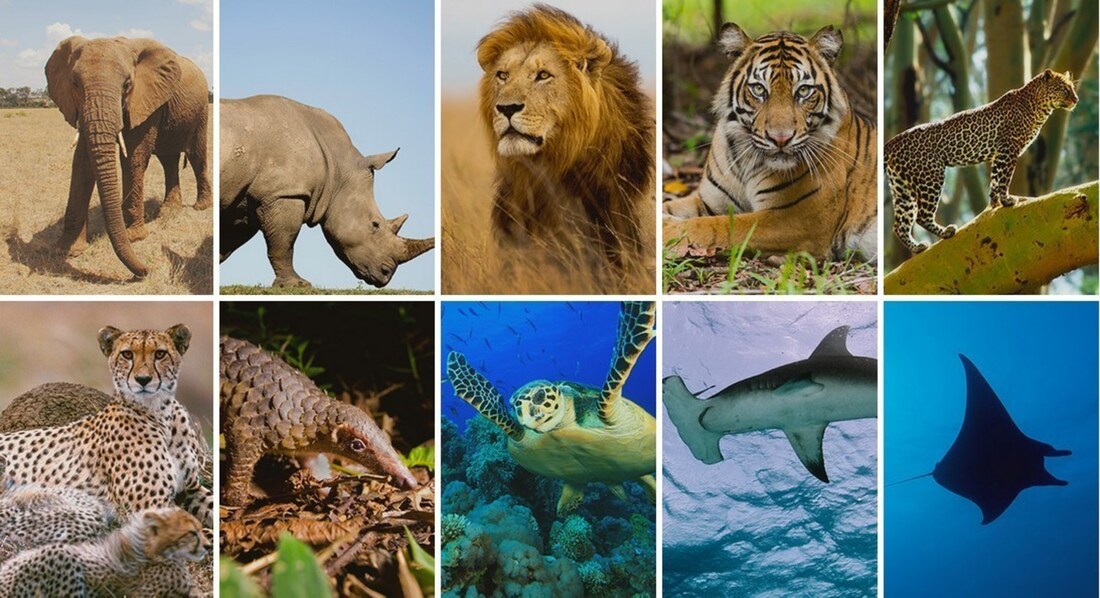|
By: Althea Ocomen An endangered species is a specific group of organisms that are threatened by extinction. Species become endangered for two main reasons: loss of habitat and loss of genetic variation. Loss of Habitat
A loss of habitat can happen naturally. Dinosaurs, for instance, lost their habitat about 65 million years ago because of the change in their environment. The hot, dry climate of the Cretaceous period changed very quickly and dramatically, most likely caused by an asteroid striking the Earth. The impact of the asteroid forced debris into the atmosphere, reducing the amount of heat and light that reached Earth’s surface and affecting the dinosaurs’ environment drastically. The dinosaurs were unable to adapt to this new, cooler habitat and became an endangered species before ultimately dying out of extinction. However, human activity can also contribute to a loss of habitat through many different harmful actions and decisions. Development for housing, industry, and agriculture reduces and destroys the habitat of native organisms both directly or indirectly affecting certain species. In the Amazon rainforest of South America, developers have cleared hundreds of thousands of acres by removing all trees and vegetation from it through deforestation and forest fires. The Amazon rainforest is cleared for cattle ranches, logging, and urban use. Loss of habitat may happen as further development takes place in a species range, disrupting the native animals’ environment which often ranges hundreds of square kilometers. The mountain lion of North America, for instance, has a range of up to 1,000 square kilometers (386 square miles). To successfully live and reproduce, a single mountain lion patrols this territory for security and safety. Urban areas, such as Los Angeles, California, and Vancouver, Canada, grew rapidly during the 20th century. As these areas expanded into the wilderness, the mountain lion’s habitat became smaller, making it harder for them to reproduce. The remaining untouched regions of the habitat can only support fewer mountain lions, and that number continues to decrease. Luckily, enormous parts of the Sierra Nevada, Rocky, and Cascade mountain ranges remain undeveloped, so mountain lions are not endangered. However, many other species have been driven out of their homes and forced to live in unsuited environments because of the invasion in their habitats. Loss of habitat can also lead to increased encounters between wild species and people. As development brings people deeper into a species range, they may have more exposure to wild species from the jungle. Poisonous plants and fungi may grow closer to homes and schools, harming children and families. Wild animals are also spotted more frequently because their habitat is in closer proximity with developed communities. These animals are simply patrolling their range, but interactions with people can be deadly. Polar bears, mountain lions, and alligators are all predators brought into close contact with people as they lose their habitat to homes, farms, and businesses. As people kill these wild animals through pesticides, accidents such as collisions with cars, or hunting, native species may become endangered and vulnerable to extinction. Loss of Genetic Variation Genetic variation is the diversity found within a species. It’s the reason why human beings may have blond, red, brown, or black hair and varying facial features. Genetic variation allows species to adapt to changes in their environment. Usually, the greater the population of a species, the greater its genetic variation. Inbreeding is a reproduction process that mates closely related family members. Groups of species with a tendency to inbreed usually have little genetic variation because no new genetic information is introduced to the group, and there continues to be the same DNA being circulated. Contracting a disease is much more likely since the genetic material is continuously passed on, and may become much more deadly among inbred groups. Inbred species do not have the genetic variation to develop resistance to diseases and illnesses. For this reason, fewer offspring of inbred groups survive to maturity. Loss of genetic variation can occur naturally as well. Cheetahs are a threatened species native to Africa and Asia. These big cats have very little genetic variation and diversity of heredity. According to biologists, cheetahs went through a long period of inbreeding during the last ice age. As a result, there are very few genetic differences among cheetahs. They cannot adapt to changes in the environment as quickly as other animals, and fewer cheetahs survive to maturity or adulthood. Cheetahs are also much more difficult to breed in captivity than other big cats, such as lions, because of the environmental dangers. Human activity can also lead to a loss of genetic variation. Overhunting and overfishing have reduced the populations of many animals, declining their growth as a species. A reduced population means there are fewer breeding pairs. A breeding pair is made up of two mature members of the species that are not closely related and can produce healthy offspring with genetic variation. With fewer breeding pairs, genetic variation declines as inbreeding becomes the more common and easily accessible practice for animals. While the loss of habitat and loss of genetic diversity does occur naturally in many environments, many decisions and actions driven by humans contribute to the continued loss of entire animal populations. We need to be conscious of the conditions that perpetuate the endangerment of animals and take responsibility for the damage we may be causing to the environment. Sources: National Geographic https://www.nationalgeographic.org/encyclopedia/endangered-species/ One Kind Planet https://onekindplanet.org/top-10/top-10-worlds-most-endangered-animals/
1 Comment
5/30/2023 07:22:55 pm
ESSAY ON HEALTHY FOOD IN HINDI
Reply
Leave a Reply. |
TUGIWelcome to Seeds for Thought, the TUGI Blog where we will be highlighting incredible stories of environmental activists and change makers, environmental news, and tips to living a more green and sustainable lifestyle. If you are interested in learning more about what we are doing on a monthly basis, subscribe to our TUGI Newsletter. Archives
May 2021
Categories |
TUGI
|
|

 RSS Feed
RSS Feed
